






8.5. Connecting to the Internet [src1] [src2]
Internet Service Providers [src]
An Internet service provider (ISP) is a company that provides access to the Internet. Access ISPs connect customers to the Internet using copper, wireless or fiber connections. Hosting ISPs provide email, web-hosting, or online storage services. Other services include virtual server, cloud services, or physical server operation. Transit ISPs interconnect other ISPs.
The internet started off as a closed network between government research laboratories and relevant parts of universities. As the Internet opened to the public, it grew and became more popular. Schools, libraries and businesses expanded access to more students and employees. Use of the Internet and growth became explosive with more businesses, organizations and individuals all needing to be connected. The commercial Internet Service Provider industry developed to fill this need. Existing private commercial networks (with millions of members), such as AOL, Prodigy, CompuServe, and GEnie opened their networks and provided ISP services for their members.
Hosting ISPs
Hosting ISPs routinely provide email, FTP, and web-hosting services. Other services include virtual machines, clouds, or entire physical servers where customers can run their own custom software. Hosts for individuals are relatively cheap and can be found for free.
 Free Internet Access
Free Internet AccessThis guide is for an Access ISP and includes a lot of wireless.
Transit ISPs
Just as their customers pay them for Internet access, ISPs themselves pay upstream (transit) ISPs for Internet access. An upstream ISP usually has a larger network than the contracting ISP and/or is able to provide the contracting ISP with access to parts of the Internet the contracting ISP by itself has no access to.
In the simplest case, a single connection is established to an upstream ISP and is used to transmit data to or from areas of the Internet beyond the home network; this mode of interconnection is often cascaded multiple times until reaching a Tier 1 carrier — Tier 1 carriers can reach any network in the Internet without having to use a higher-level ISP. In reality, the situation is often more complex. ISPs with more than one point of presence (PoP) – an access point to the Internet – may have separate connections to an upstream ISP at multiple PoPs, or they may be customers of multiple upstream ISPs and may have connections to each one of them at one or more point of presence.
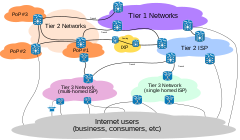
Tier 3 to 2 to 1
By User:Ludovic.ferre (Internet Connectivity Distribution&Core.svg) [CC-BY-SA-3.0], via Wikimedia Commons
Access ISPs
Access ISPs employ a range of technologies to enable consumers to connect to their network. (This is the ISP type that you likely have for home use.)
For individuals, homes, and small businesses, the most popular options include dial-up, DSL, broadband wireless, cable modem, and fiber to the home (FTTH). Other options are available for customers with more demanding requirements.
Mailbox ISPs
A mailbox provider is an organization that provides services for hosting electronic mail domains with access to storage for mail boxes. It provides email servers to send, receive, accept, and store email for end users or other organizations. Many mailbox providers are also access providers. This category includes email hosting services, as well as the relevant department of companies, universities, organizations, groups, and individuals that manage their mail servers themselves. The task is typically accomplished by implementing Simple Mail Transfer Protocol (SMTP) and possibly providing access to messages through Internet Message Access Protocol (IMAP), the Post Office Protocol, Webmail, or a proprietary protocol.

Various type of Internet connections for consumer and businesses
By User:Ludovic.ferre (Internet_Connectivity_Overview2_Access.svg) [CC-BY-SA-3.0], via Wikimedia Commons

Comparison of email services
Note that all providers limit the size of an attachment.
Typical home user access connection
Dial-up [src]
Dial-up Internet access is a form of Internet access that uses the facilities of the public switched telephone network (PSTN) to establish a dialed "voice" connection to an Internet service provider (ISP) via telephone lines, sometimes called plain-old telephone service. The user's computer or router uses an attached modem to encode and decode Internet Protocol packets and control information into and from analog audio frequency signals, respectively. During the time of connection, normal telephone service (voice calls) is unavailable.
Dial-up connections to the Internet require no infrastructure other than the telephone network and a modem at each end of the connection. Dial-up is often the only choice available for rural or remote areas, where broadband installations are not prevalent due to low population density, and high infrastructure cost. Dial-up access is inexpensive and even offered free by some ISPs. It is estimated that in 2008, 10 percent of US adults still used dial-up Internet access, though by 2013, that number had fallen to just 3%.
Dial-up requires time to establish a telephone connection and perform handshaking for protocol synchronization before data transfers can take place. In locales with telephone connection charges, each connection incurs an incremental cost. If calls are time-metered, the duration of the connection incurs costs. Dial-up access is a transient connection. The connection may be terminated by the user, perhaps to make or receive calls, the ISP, perhaps as matter of policy (time limit), or the phone company, usually as an error.
Modems are related to codecs. They perform the complementary (opposite) task.

Modulated wave
By Brews ohare (Own work) [CC-BY-SA-3.0 or GFDL], via Wikimedia Commons
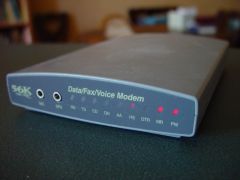
Dial-up modem
From public-domain-image.com
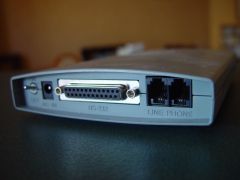
Dial-up modem, back panel
From public-domain-image.com
Performance
Dial-up modems have a maximum theoretical transfer speed (bandwidth) of 56 Kbit/s, although in most cases 40–50 Kbit/s is the norm. Factors such as phone line noise, as well as the quality of the modem itself, play a large part in determining connection speeds. Dial-up connections usually have latency as high as 300 ms or even more, this is longer than for many forms of broadband, such as cable or DSL, but typically less than satellite connections. Longer latency can make online gaming or video conferencing difficult, if not impossible. An increasing amount of Internet content such as streaming media will not work at dial-up speeds.
At 56 Kbps, an 8 MB photo will take at least 19 minutes to download!
DSL - Digital Subscriber Line [src]
Digital Subscriber Line (DSL) is a family of technologies that provides broadband digital data transmission over the wires of a local telephone network. In telecommunications marketing, the term Digital Subscriber Line is widely understood to mean Asymmetric Digital Subscriber Line (ADSL), the most commonly installed variety of DSL. DSL service is delivered simultaneously with regular telephone on the same telephone line, i.e., voice telephone service is not disrupted as it is with dial-up. This is possible because data is transmitted at a different frequency than voice. These frequency bands are subsequently separated by filtering.
Like dial-up, DSL uses the existing phone lines, keeping installation cost low and making it available where other ISP connection modes may not be. Some additional equipment (infrastructure) is needed to support DSL. Filters for phones and a DSL modem are needed in the home to combine the data streams. The telephone company splits the signal into voice and data streams with the data routed to a DSLAM. (Voice data is routed to "plain old telephone service".)
Like a dial-up modem, DSL goes through a connection (login) phase. However, the DSL modem can stay connected for long periods of time (without affecting voice service).

ADSL Modem
By Feureau (Own work) [CC-BY-SA-3.0 or GFDL], via Wikimedia Commons
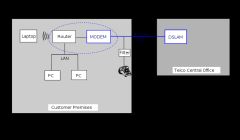
ADSL schematic
By Jhbdel. Licensed under the Creative Commons Attribution-ShareAlike 3.0
Performance
The data throughput of consumer DSL services typically ranges from 3 Mbit/s to 5 Mbit/s in the direction to the customer (downstream), depending on DSL technology, line conditions, and service-level implementation. In ADSL, the data throughput in the upstream direction, (i.e. in the direction to the service provider) is lower, hence the designation of asymmetric service. Upstream speed is typically in the range of 600 Kbit/s - 1 Mbit/s. Latency, or the amount of time for a packet to arrive (delay time), is low and comparable to cable ISPs.
The asymmetric disparity is because you request a web page by sending a (very small) URL, while the result may be a web page full of images. However, peer-to-peer file sharing expects to send large amounts of data in both directions, hence ADSL may not be a good choice if you use a lot of P2P applications.
At 2 MBit/s, an 8 MB photo would take over 30 seconds to download.
AT&T listed 13 tiers of service when I checked (in 2016). The lowest was 800 Kbps - 1.5 Mbps. The highest was 500 Mbps - 940 Mbps. That range varies by a factor of almost 1000 times. Clearly, you need to look at what is reasonably available in your area.
Cable Internet [src]
Cable Internet access is a form of broadband Internet access that uses the cable television infrastructure, where it is available. Like digital subscriber line and fiber to the premises services, cable Internet access provides network edge connectivity (last mile access) from the Internet service provider to an end user. It is integrated into the cable television infrastructure analogously to DSL which uses the existing telephone network. Cable TV networks and telecommunications networks are the two predominant forms of residential Internet access. Although, recently, both have seen increased competition from fiber deployments, wireless, and mobile networks.
Broadband cable Internet access requires a cable modem at the customer's premises and a cable modem termination system at a cable operator facility. The two are connected via coaxial cable or a Hybrid Fiber Coaxial (HFC) plant. While access networks are sometimes referred to as last-mile technologies, cable Internet systems can typically operate where the distance between the modem and the termination system is up to 100 miles (160 km). If the HFC network is large, the cable modem termination system can be grouped into hubs for efficient management.

Cable modems
Lcj at the Polish language Wikipedia [GFDL or CC-BY-SA-3.0], from Wikimedia Commons
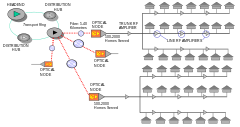
HFC Network Diagram
By HFC_Network_Diagram.png: Unforgettable fan en:User:Unforgettable fanVectorised by: Jffner (HFC_Network_Diagram.png) [Public domain], via Wikimedia Commons
Performance
Downstream bit rates can be as much as 400Mbit/s for business connections, and 250Mbit/s for residential service in some countries. Typical home rates are 10 to 30 Mbps downstream and 1 Mbps to 5 Mbps upstream. One downstream channel can handle hundreds of cable modems. Although operating at higher speeds than DSL, service is still asymmetric potentially affecting P2P applications.
Cable Internet shares the access network among a population of local users. The network operator uses statistical multiplexing, a bandwidth sharing technique which is employed to distribute bandwidth fairly, in order to provide an adequate level of service at an acceptable price. However, the operator has to monitor usage patterns and scale the network appropriately, to ensure that customers receive adequate service even during peak-usage times. If the network operator does not provide enough bandwidth for a particular neighborhood, the service can become sluggish at peak use times. Operators have been known to use a bandwidth cap, or other bandwidth throttling technique; users' download speed is limited during peak times, if they have downloaded a large amount of data that day.
At 8 MBit/s, an 8 MB photo would take at least 8 seconds to download.
Fiber to the Premises [src]
Fiber to the x (FTTx) is a generic term for any broadband network architecture that uses optical fiber to replace all or part of the usual copper "local loop" used for last mile telecommunications. Fiber-to-the-home (FTTH) fiber reaches the boundary of the living space, such as a box on the outside wall of a home. This infrastructure change limits availability to locations where the ISP's return on investment is sufficient to make the service available.
The speeds (bandwidth) of fiber optic and copper cables are both limited by length, but copper is much more sharply limited in this respect. For example, gigabit Ethernet runs over relatively economical Category 5e or Category 6 unshielded twisted pair copper cabling but only to 100 meters. However, over the right kind of fiber, gigabit Ethernet can easily reach distances of tens of kilometers. Using fiber for even part of the physical path shortens the remaining copper segments and allows them to run much faster.
The simplest optical distribution network can be called direct fiber. In this architecture, each fiber leaving the central office goes to exactly one customer. Such networks can provide excellent bandwidth since each customer gets their own dedicated fiber extending all the way to the central office. However, this approach is more costly due to the amount of fiber and central office machinery required. More commonly, each fiber leaving the central office is actually shared by many customers. It is not until such a fiber gets relatively close to the customers that it is split into individual customer-specific fibers. Once on private property, the signal typically travels the final distance to the end user's equipment using an electrical format.

Comparison of non-fiber distance for fiber to the Node, Cabinet, Basement & Home (FTTx)
By Riick (Own work) [GFDL or CC-BY-SA-3.0], via Wikimedia Commons

Two ways to split fiber signal: active & passive
By Riick (Own work) [GFDL or CC-BY-SA-3.0], via Wikimedia Commons
Performance
Fiber configurations that bring fiber right into the building can offer the highest speeds since the remaining segments can use standard Ethernet or coaxial cable. Fiber configurations that transition to copper in a street cabinet are generally too far from the users for standard Ethernet configurations over existing copper cabling. They generally use VDSL (Very-high-bitrate DSL) at up to 52 Mbit/s downstream and 16 Mbit/s upstream.
For Verizon FiOS, residential customers usually have three or more choices for Internet bandwidth. Current tiers are:
| Download speed | Upload speed |
|---|---|
| 50 Mbps | 50 Mbps |
| 100 Mbps | 100 Mbps |
| 150 Mbps | 150 Mbps |
| 300 Mbps | 300 Mbps |
| 500 Mbps | 500 Mbps |
At 50 MBit/s, an 8 MB photo would take 1.25 seconds to download.

FiOS ONT (Optical Network Terminator) at home – public domain image
- 3G [src]
- 3G or 3rd generation mobile telecommunications, is a generation of standards for mobile phones and mobile telecommunication services fulfilling the IMT-2000 specifications by the International Telecommunication Union. Application services include wide-area wireless voice telephone, mobile Internet access, video calls and mobile TV, all in a mobile environment. To meet the IMT-2000 standards, a system is required to provide peak data rates of at least 200 Kbit/s. Actual speed varies depending on the carrier you choose and location, but you can expect 500 Kbit/s to 2 Mbit/s with fairly high latency times.
- 3.5G [src]
- Recent 3G releases, often denoted 3.5G and 3.75G, also provide mobile broadband access of several Mbit/s to smartphones and mobile modems in laptop computers. With the usual caveats, you can expect 3-7 Mbit/s.
- 4G [src]
- 4G is the fourth generation of cellular wireless standards. It is a successor to the 3G and 2G families of standards. The requirements for 4G standards set peak speed requirements for 4G service at 100 Mbit/s for high mobility communication (such as from trains and cars) and 1 Gbit/s for low mobility communication (such as pedestrians and stationary users).
- LTE [src]
- Technically, this is 3GPP Long Term Evolution. Although LTE is often marketed as 4G, first-release LTE does not fully comply with the IMT Advanced 4G requirements. The LTE specification provides downlink peak rates of at least 100 Mbps, and uplink of at least 50 Mbps and round-trip times (latency) of less than 10 ms. Expect 16-25 Mbit/s download speed.
- WiMAX [src]
- WiMAX (Worldwide Interoperability for Microwave Access) is a telecommunications protocol that provides fixed and mobile Internet access. The current WiMAX revision provides up to 40 Mbit/s with the IEEE 802.16m update expected to offer up to 1 Gbit/s fixed speeds. Expect 6-15 Mbit/s.
Broadband Wireless [src]
Wireless Broadband is a fairly new technology that provides high-speed wireless Internet access access over a wide area. Wireless Broadband networks feature speeds roughly equivalent to wired broadband networks, such as that of ADSL or a cable modem. Wireless Broadband networks can also be symmetrical, meaning bandwidth traveling in both directions (download/upload) are the same. This is most commonly associated with 'fixed wireless' networks (as opposed to mobile or cellular networks).
Initially, Wireless ISPs (WISPs) were only found in rural areas not covered by cable or DSL. These early WISPs would employ a high-capacity carrier and then broadcast the signal from a high elevation, such as at the top of a water tower. To receive this type of Internet connection, consumers mount a small dish to the roof of their home or office and point it to the transmitter. Line of sight is usually necessary for WISPs operating in the 2.4 and 5 GHz bands, with 900 MHz offering better NLOS (non-line-of-sight) performance.
The Federal Communications Commission (FCC) recently re-defined the definition of broadband to mean download speeds of at least 25 Mbit/s and upload speeds of at least 3 Mbit/s.

Three 45 Mbit/s wireless dishes
public domain image
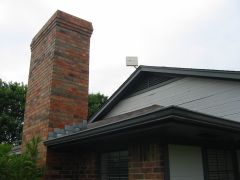
Typical WISP Customer Premises Equipment (CPE) – public domain image
Mobile Broadband
Wireless broadband technologies include new services from companies such as Verizon, Sprint, and AT&T Mobility, which allow a more mobile version of broadband access. Consumers can purchase a PC card, laptop card, or USB equipment to connect their PC or laptop to the Internet via cell phone towers. This type of connection would be stable in almost any area that could also receive a strong cell phone connection. These connections can cost more for portable convenience as well as having speed limitations in all but urban environments.

Option GT 3G+ UMTS PC-card
By Woookie (Own work) [CC-BY-SA-3.0], via Wikimedia Commons
Wireless broadband includes mobile standards used for smartphones, laptops and PCs. However, in this rapidly developing area, marketing terminology has caused considerable confusion.







